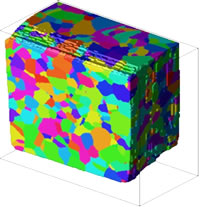The Materials Research Science and Engineering Center (MRSEC) is an interdisciplinary research and educational enterprise within Carnegie Mellon University dedicated the understanding, control and optimization of grain boundary dominated materials properties. The collaboration of researchers with complementary backgrounds, skills, and knowledge is critical to meeting the Center's technical objectives.
 Most metallic and ceramic materials used in aircraft, automobiles, and devices such as computers are polycrystalline. In other words, they are made up of many microscopic crystals held together by grain boundaries. It is widely recognized that the types of grain boundaries in a material and the manner in which they are connected affect a wide range of properties and, ultimately, a material's performance and lifetime. In most cases, however, our ability to predict and control the materials properties that are governed by the grain boundaries is severely limited by our incomplete knowledge of the network structure and the behavior of individual interfaces. The CMU MRSEC's goals are to understand the origins of the quantifiable characteristics of polycrystals that arise during processing, to develop strategies for influencing these characteristics in predictable ways, and to define microstructural metrics that can be directly related to macroscopic properties and performance. The Center's tools and findings will have applications in a range of practical materials processing applications and, to insure rapid implementation, we work collaboratively with government, industry, and international laboratories.
Most metallic and ceramic materials used in aircraft, automobiles, and devices such as computers are polycrystalline. In other words, they are made up of many microscopic crystals held together by grain boundaries. It is widely recognized that the types of grain boundaries in a material and the manner in which they are connected affect a wide range of properties and, ultimately, a material's performance and lifetime. In most cases, however, our ability to predict and control the materials properties that are governed by the grain boundaries is severely limited by our incomplete knowledge of the network structure and the behavior of individual interfaces. The CMU MRSEC's goals are to understand the origins of the quantifiable characteristics of polycrystals that arise during processing, to develop strategies for influencing these characteristics in predictable ways, and to define microstructural metrics that can be directly related to macroscopic properties and performance. The Center's tools and findings will have applications in a range of practical materials processing applications and, to insure rapid implementation, we work collaboratively with government, industry, and international laboratories.